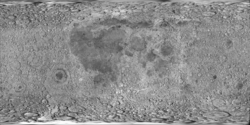| Manilius Cráter lunar | ||
|---|---|---|
 Imagen de la misión Lunar Orbiter 4 | ||
| Coordenadas | 14°27′N 9°04′E / 14.45, 9.07 | |
| Diámetro | 39 km | |
| Profundidad | 3.1 km | |
| Colongitud | 351° al amanecer | |
| Epónimo | Marco Manilio | |
|
Localización sobre el mapa lunar | ||


Manilius es un cráter de impacto lunar situado en el borde noreste del Mare Vaporum.
 |
 |
Presenta un borde bien definido, con una superficie interior inclinada que se extiende directamente hasta el montículo de rocas en forma de anillo en la base, y una pequeña rampa exterior. El pequeño interior del cráter tiene un albedo más alto que el entorno, y aparece brillante cuando el sol se sitúa elevado sobre el horizonte. Dentro del cráter se localiza una formación de picos centrales cerca del punto medio. El cráter también posee un sistema de marcas radiales que se extiende a una distancia de más de 300 kilómetros.
YouTube Encyclopedic
-
1/3Views:3 4148 51361 004
-
A. E. Housman "Here Dead We Lie" Poem animation WW1
-
A.E. Housman "When I was one-and-twenty" Poem animation
-
What is Astrology?
Transcription
Nombres
Manilius lleva el nombre del astrónomo romano Marco Manilio. Como muchos de los cráteres del lado visible de la Luna, recibió su nombre de Giovanni Riccioli, cuyo sistema de nomenclatura ideado en 1651 se ha estandardizado.[1] Los cartógrafos lunares anteriores habían dado a este elemento diversos nombres. En el mapa de 1645 de Michael van Langren se denominaba "Isabellae Reg Hisp." (en honor de Isabel Clara Eugenia, infanta de España)[2] y Johannes Hevelius lo llamó "Insula Besbicus" en referencia a la isla de Turquía actualmente conocida como Imrali.[3]
Cráteres satélite
Por convención estos elementos son identificados en los mapas lunares poniendo la letra en el lado del punto medio del cráter que está más cercano a Manilius.
 |
|
Los siguientes cráteres han sido renombrados por la UAI:
Véase también
Referencias
- ↑ Ewen A. Whitaker, Mapping and Naming the Moon (Cambridge University Press, 1999), p.61.
- ↑ Ewen A. Whitaker, Mapping and Naming the Moon (Cambridge University Press, 1999), p. 198.
- ↑ Ewen A. Whitaker, Mapping and Naming the Moon (Cambridge University Press, 1999), p. 202.
- (WGPSN), IAU Working Group for Planetary System Nomenclature (13 de febrero de 2013). «Gazetteer of Planetary Nomenclature. 1:1 Million-Scale Maps of the Moon» (en inglés). UAI / USGS. Consultado el 6 de abril de 2016.
- Andersson, L. E.; Whitaker, E. A., (1982). NASA Catalogue of Lunar Nomenclature (en inglés). NASA RP-1097.
- Blue, Jennifer (25 de julio de 2007). «Gazetteer of Planetary Nomenclature» (en inglés). USGS. Consultado el 2 de enero de 2012.
- Bussey, B.; Spudis, P. (2004). The Clementine Atlas of the Moon (en inglés). Nueva York: Cambridge University Press. ISBN 0-521-81528-2.
- Cocks, Elijah E.; Cocks, Josiah C. (1995). Who's Who on the Moon: A Biographical Dictionary of Lunar Nomenclature (en inglés). Tudor Publishers. ISBN 0-936389-27-3.
- McDowell, Jonathan (15 de julio de 200). «Lunar Nomenclature» (en inglés). Jonathan's Space Report. Consultado el 2 de enero de 2012.
- Menzel, D. H.; Minnaert, M.; Levin, B.; Dollfus, A.; Bell, B. (1971). «Report on Lunar Nomenclature by The Working Group of Commission 17 of the IAU». Space Science Reviews (en inglés) 12: 136.
- Moore, Patrick (2001). On the Moon (en inglés). Sterling Publishing Co. ISBN 0-304-35469-4.
- Price, Fred W. (1988). The Moon Observer's Handbook (en inglés). Cambridge University Press. ISBN 0521335000.
- Rükl, Antonín (1990). Atlas of the Moon (en inglés). Kalmbach Books. ISBN 0-913135-17-8.
- Webb, Rev. T. W. (1962). Celestial Objects for Common Telescopes, 6ª edición revisada (en inglés). Dover. ISBN 0-486-20917-2.
- Whitaker, Ewen A. (2003). Mapping and Naming the Moon (en inglés). Cambridge University Press. 978-0-521-54414-6.
- Wlasuk, Peter T. (2000). Observing the Moon (en inglés). Springer. ISBN 1-85233-193-3.
- «Lunar Impact Crater Database» (en inglés). Lunar and Planetary Institute (USRA). Consultado el 12 de septiembre de 2017.
Enlaces externos
- Referencia UAI del CRÁTER
- LPI Digital Lunar Orbiter Photographic Atlas of the Moon
- Mapa LROC
- The-moon.wikispaces.com: Manilius Archivado el 7 de mayo de 2018 en Wayback Machine.
 Wikimedia Commons alberga una categoría multimedia sobre Manilius.
Wikimedia Commons alberga una categoría multimedia sobre Manilius.

